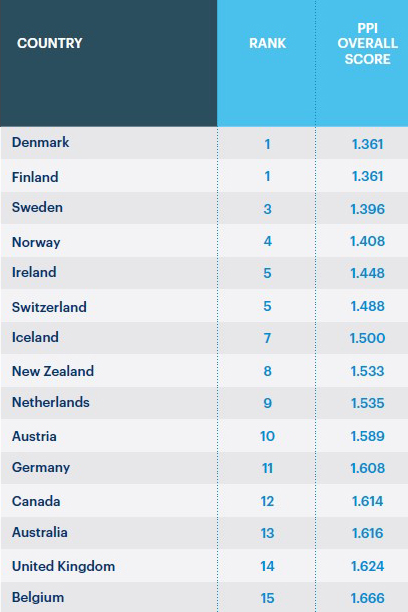 The Institute for Economics and Peace has supplemented their Global Peace Index with a Positive Peace Report 2016. But be warned, at 94 pages, it’s not a light read.
The Institute for Economics and Peace has supplemented their Global Peace Index with a Positive Peace Report 2016. But be warned, at 94 pages, it’s not a light read.
The framework used to measure positive peace is based on eight factors (pillars of peace) which are shown right, with a scoring system based on the winner having a low positive peace index (PPI) of near one (1) with others being higher.
Here are the top 15 countries in the PPI:

Given that the bottom countries have a PPI score greater than four, Australia’s 1.616 isn’t really too far behind the winner’s 1.361.
It’s worth looking at the winners by pillar:
| Pillar | Winner | Runnerup | Australia’s place |
| Well functioning government | Denmark | Finland | 6th |
| Low levels of curruption | New Zealand | Denmark | 7th |
| Sound business environment | Singapore | New Zealand | 3rd |
| Equitable distribution of resources | Sweden | Israel | 10th |
| Acceptance of the right of others | Sweden | Iceland | 8th |
| Free flow of information | Finland | Estonia | 19th |
| High level of human capital | United Kingdom | Ireland | 17th |
| Good relations with neighbours | Ireland | Austria | 64th |
Much as we might be discomforted by our placing in Information and Human Capital what a shocker that we could be 64th on neighbourliness.
Before we get too excited note that New Zealand is 54th which isn’t too far off our score. Does New Zealand have neighbours? One supposes so but they are all some distance away.
Page 41 documents the basis of the pillar Good Relations with Neighbours:
- hostility to foreigners- measures social attitudes toward foreigners and private property
- number of visitors- as per cent of the domestic population
- regional integration- measures the extent of a nation’s trade-based integration with other states
Number of vistors must be grossly unfair to both Australia and New Zealand because of the distance from other countries. Austria, which ranks second for neighbourliness, gets 25 million tourist arrivals a year or about 3.0 per head of population; Australia gets 7 million (less than 0.3 per head of population) source http://data.worldbank.org/indicator/ST.INT.ARVL.
One wonders if the Institute for Economics and Peace adjusts for length of stay by tourists. No one comes to our part of the world for a day or two whereas day visitors to Austria from border countries would be a significant proportion of the total.
The last item – trade integration – also raises queries. For starters is it really a matter for a ‘peace’ index? A country that promotes autarky (self-sufficiency, minimise imports) can still have peaceful relationships with neighbours even if some might be frustrated at the lack of export opportunities.
It’s a moot point whether trade data should be adjusted for the import component of exports, ie the exports have low value added if the import component is high.
Ireland ranks first under this pillar. It maybe that the main factor contributing to this is the high proportion of exports to GDP (about 40% per data published in Wikipedia) but to the extent that the exports consist of re-invoicing imports by multinationals to take advantage of Ireland’s tax competitiveness, Ireland is not a neighbourly country.
If we take out neighbourliness from the data and assume that all criteria have an equal weighting, Australia would move up to eighth position.
A quick word about other countries. The US ranks 19th, Brazil 63rd, China 85th, Russia 93rd and India 107th. Almost all the bottom countries are in Africa with Somalia the last of the 162 countries surveyed.
This a follow-up article written by Jim Wells to an article of the same name published in July 2016.

